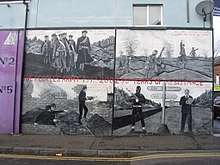Murals and graffiti
Murals and graffiti is something you frequently encounter in urban environments.
Understand

As long as mankind has been able to paint, people have been drawing and scribbling on surfaces. The oldest versions of these are thousands of years old, found inside caves and sometimes even listed as UNESCO World Heritage sites. Later on, especially churches and other religious buildings were decorated with pictures, especially on the inside. Some cities employ murals for political propaganda or advertising while others hope to take advantage of a "code of honor" that some graffiti sprayers feel bound by, not to spray on the work of another. Regardless of the reason, such murals can be beautiful and interesting to look at in their own right.
Unwanted murals or scribble is known as graffiti. While it's far from a modern phenomenon, most people probably associate it with youth vandalizing public and private property using spray paint. However, nowadays there are established graffiti artists, graffiti events and "legal" walls. Graffiti paintings in this context often resemble artworks rather than illegible tags. Ancient Roman graffiti (such as is found in Pompeii) provides insight into pronunciation (through their misspellings) as well as the mood of the times and the sometimes crude humor of the "common people".
Destinations

- Belfast is world famous for its political murals, supporting both the nationalist and loyalist sides in the Northern Irish conflict.
- In Alpine countries you may find houses decorated with, say, people in traditional clothing, flowers or landscapes.
- The Painted Monasteries of Bukovina and other religious buildings around the world.
- The Berlin Wall no longer stands, but pieces and parts of it have been saved and put on display in the city itself and elsewhere. On them you can see graffiti and paintings, or at least part of them.
- Many of the walls in the "free town" of Christiania are covered by colourful murals.
- The Mission District of San Francisco is well-known for its murals in alleys.
- Nicaragua has a pre-columbian tradition of petroglyphs that was expanded upon and revived in the Sandinista era (1979-1990) for political purposes. As the Sandinistas are in power again since 2006, political murals make no sign of going away any time soon. If you are in León or Estelí make sure to check them out, as they are particularly plentiful in those Sandinista strongholds.
See also
- Modern and contemporary art
- Signs
- Urban rail — where you often can find both legal and illegal paintings
- Urbex